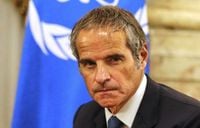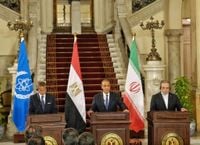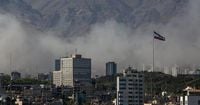On September 9, 2025, a diplomatic breakthrough unfolded in Cairo as Iran and the International Atomic Energy Agency (IAEA) signed a new cooperation framework, marking the first significant step toward restoring nuclear oversight since the dramatic suspension of inspections three months earlier. The agreement, a product of negotiations between Iranian Foreign Minister Abbas Araghchi and IAEA Director-General Rafael Grossi, has been described by Grossi as “an important step in the right direction,” signaling cautious optimism after a tense summer of military conflict and diplomatic standoffs.
This latest development comes in the wake of a turbulent episode in June, when a 12-day war saw Israeli and U.S. forces bomb Iranian nuclear facilities. The strikes, which Iran labeled as illegal attacks on its peaceful nuclear program, prompted Tehran to halt all cooperation with the UN nuclear watchdog. Inspectors from the IAEA, who had previously monitored Iran’s uranium enrichment activities, suddenly found themselves locked out, unable to verify the status of Iran’s near bomb-grade uranium stockpiles. According to Reuters, Iran’s parliament quickly passed a law suspending cooperation, requiring all future inspections to be authorized by the Supreme National Security Council (SNSC).
At the heart of Tuesday’s agreement is a new document titled “Technical Modalities for Implementation of Inspections between the Islamic Republic of Iran and the IAEA.” While precise details remain scant, both parties have agreed on “practical modalities to resume inspection activities in Iran,” as Grossi announced on X (formerly Twitter) and reiterated at a joint press conference in Cairo. The framework is designed to streamline the inspection process, potentially paving the way for IAEA access to sites that have been off-limits since the conflict.
Egyptian Foreign Minister Badr Abdelatty, who hosted the high-profile meeting, welcomed the deal, saying it could mark “a real starting point for a new relationship characterized by greater transparency in dealing with security issues.” Abdelatty further expressed hope that this agreement would not only facilitate understanding with European powers—who have threatened to reimpose sanctions—but also “lead to a return to the negotiation table between Iran and the United States,” as reported by The Times of Israel.
Despite the cautious optimism, the agreement is laced with caveats and warnings. Iranian Foreign Minister Araghchi made it clear that Tehran’s cooperation is conditional. “In the event of any hostile action against Iran, including the reinstatement of annulled U.N. Security Council resolutions, Iran will consider its cooperation with the agency to have come to an end,” Araghchi warned, according to a statement cited by Reuters. This sentiment was echoed by Iranian foreign ministry spokesman Esmaeil Baqaei, who stated on state television that the new understanding was forged “in light of the new situation following the United States illegal attacks on Iran’s peaceful nuclear facilities.”
The stakes are high. European powers—France, Britain, and Germany, collectively known as the E3—have initiated the so-called “snapback” process, threatening to reimpose wide-ranging sanctions on Iran that were previously lifted under the 2015 nuclear deal. The E3 have made it clear that unless Iran allows inspections to resume, accounts for its highly enriched uranium stockpile, and re-engages in nuclear talks with the United States, sanctions will be back on the table by late September. The new framework aims to address at least the first two of these conditions, but as diplomats have cautioned, “the devil is in the detail.”
For now, key sites bombed in June remain off-limits to inspectors, and the IAEA has not been able to verify the fate of Iran’s stockpile, which, according to a recent IAEA report, included uranium enriched up to 60% purity—only a short step from the 90% required for weapons-grade material. Before the attacks, Iran had amassed enough material, if further enriched, for approximately 10 nuclear weapons, based on IAEA benchmarks. The opacity surrounding Iran’s current stockpile remains a primary concern for Western governments, who continue to accuse Tehran of pursuing nuclear weapons—a charge Iran vehemently denies, maintaining its program is strictly civilian in nature.
Domestically, the agreement is expected to stir controversy. Conservative factions within Iran, emboldened by years of fruitless negotiations and recent hostilities, have grown increasingly skeptical of working with the IAEA or negotiating over the country’s nuclear program. Among the Iranian public, especially after the June conflict, there are mounting calls to revise the nation’s nuclear doctrine, which is currently anchored by a religious decree from Supreme Leader Ayatollah Seyyed Ali Khamenei prohibiting the development of nuclear weapons.
Ali Larijani, the new head of the SNSC, recently stated that Iran remains open to negotiations to assure the West it will not build nuclear weapons. However, Larijani accused the United States of setting “unacceptable preconditions,” particularly demands to include Iran’s robust missile program in the talks—a red line for Tehran. As reported by Tehran Times, Iran’s missile capabilities were a decisive factor in compelling Israel and the U.S. to seek a ceasefire in June, underscoring their strategic value in the eyes of Iranian leaders.
In the broader diplomatic landscape, the Cairo agreement is being watched closely by international stakeholders. While the deal has been praised by Egyptian President Abdel Fattah al-Sisi as “a positive step toward de-escalation,” skepticism lingers about its ability to resolve the deeper issues at play. The lack of transparency on the specifics of the inspection modalities and the conditional nature of Iran’s cooperation leave open the possibility of future breakdowns.
Still, some see the agreement as a rare glimmer of hope in an otherwise fraught situation. As Grossi put it, “This is an important step in the right direction.” Only time will tell whether this framework can deliver on its promise of increased transparency and reduced tensions—or if it will become another chapter in the long, troubled history of Iran’s nuclear diplomacy.
For now, the world waits. The coming weeks will be crucial, as Iran and the IAEA attempt to navigate a maze of political pressures, domestic opposition, and international skepticism. The stakes—regional stability, nuclear non-proliferation, and the prospect of renewed negotiations—could not be higher.



